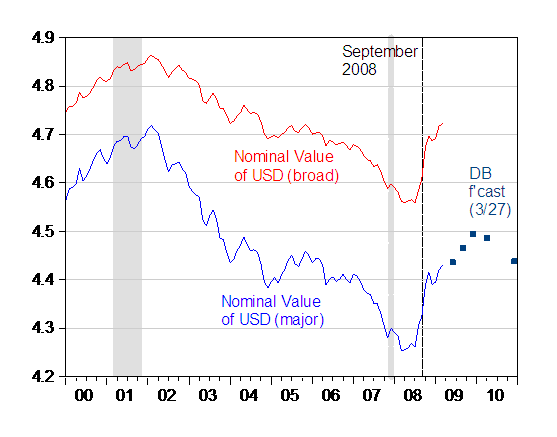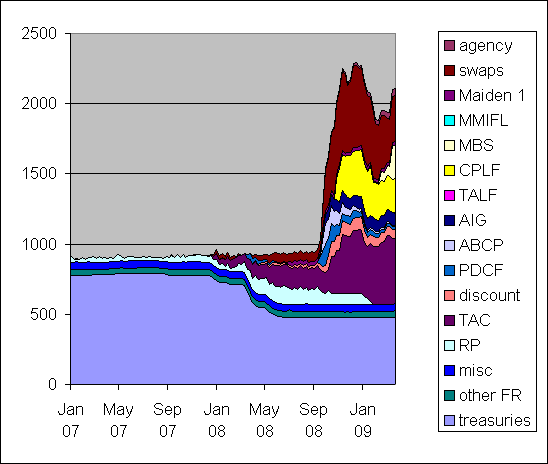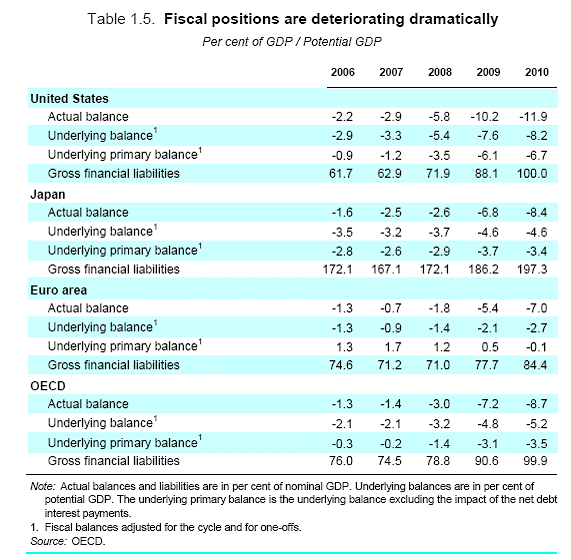Over the weekend, I was working on my long delayed manuscript on exchange rate modeling [0], and pondering how useful the conventional econometric techniques were for making predictions about the future value of the dollar.

Figure 1: Log value of trade weighted dollar, against a basket of major currencies (blue), and against a broad basket of currencies (red); and Deutsche Bank forecasts, calculated using implied changes of DB TWI (dark blue boxes). NBER defined recession shaded gray; only peak indicated for current recession. Source: Federal Reserve via FRED II, Deutsche Bank Exchange Rate Perspectives (27 March 2009), NBER, and author’s calculations.
Why wonder? Well, in the final chapter of the text, I outlined the use of Taylor rule fundamentals to explain exchange rates (see this paper and these posts [1], [2], [3]). However, the fact that several central banks have hit the zero interest rate bound, and instituted quantitative easing (QE), makes the plausibility of such models limited in the near future.

Figure 2: Assets of the Federal Reserve, in billions of dollars, seasonally unadjusted, from Jan 3, 2007 to March 25, 2009. Wednesday values, from Federal Reserve H41 release. Agency: federal agency debt securities held outright; swaps: central bank liquidity swaps; Maiden 1: net portfolio holdings of Maiden Lane LLC; MMIFL: net portfolio holdings of LLCs funded through the Money Market Investor Funding Facility; MBS: mortgage-backed securities held outright; CPLF: net portfolio holdings of LLCs funded through the Commercial Paper Funding Facility; TALF: loans extended through Term Asset-Backed Securities Loan Facility; AIG: sum of credit extended to American International Group, Inc. plus net portfolio holdings of Maiden Lane II and III; ABCP: loans extended to Asset-Backed Commercial Paper Money Market Mutual Fund Liquidity Facility; PDCF: loans extended to primary dealer and other broker-dealer credit; discount: sum of primary credit, secondary credit, and seasonal credit; TAC: term auction credit; RP: repurchase agreements; misc: sum of float, gold stock, special drawing rights certificate account, and Treasury currency outstanding; other FR: Other Federal Reserve assets; treasuries: U.S. Treasury securities held outright. Source: Hamilton, “The Fed’s new balance sheet”.
At the same time, we are witnessing a substantial increase in government debt, as documented in this post. Working off a portfolio balance model, as discussed in this post, one would expect a depreciation of the dollar or an increase in the exchange risk premium. However, all developed countries are expanding debt to GDP ratios.

Table 1.5 from OECD, Economic Outlook (March 2009) [pdf].
(Notice that gross debt differs from net debt, so these figures are not comparable to those in this post.)
Deutsche Bank, in its most recent Exchange Rate Perspectives (March 27, 2009) [not online], concludes:
Fiscal expansion combined with QE
What is the implication of fiscal expansion combined with QE? We have argued that history suggests the implications of higher fiscal deficits for the dollar will depend on whether or not the higher deficits are accompanied by higher relative US longer-term rates (Fiscal Deficits and the Dollar, ERP, September 2008). So if relatively more activist fiscal policy in the US raises relative US yields, history suggests this should be positive for the dollar. But there is widespread concern that if the higher deficits are accompanied by expectations of or actual QE, this will be negative for the dollar. This is essentially a “risk premium” argument that even with higher relative US yields, because of or under QE, this will be negative for the dollar. Looking at historical experience for episodes of risk premia against the dollar by examining the correlation between daily returns in EURUSD versus the longer-term rate differential indicates six episodes of negative correlations between the differential and the dollar. Four of these are episodes of risk premium in favor of the dollar, with declines in the dollar rate differential associated with a higher dollar. There have only been two episodes—in the late summer and early fall of 1998 and in the summer of 2003 — when a move in rate differentials in favor of the dollar was associated with a weaker dollar. There have thus historically been very few episodes of such a risk premium. Presently this correlation between changes in the yield differential and the dollar is running around zero to very modestly negative. This is consistent with the view that most of the recent sharp depreciation in the dollar has been in line with the decline in US rate differentials and there is little or no evidence that higher expected fiscal deficits in the US combined with QE have created a risk premium against the dollar …
Interestingly, this perspective contrasts with Charles Wyplosz‘s view, who argues that QE is basically a beggar thy neighbor policy. Perhaps it is, but when many countries are undertaking QE [4] [5] the effects cancel out.
What about China? As Brad Setser points out, China has slowed accumulation of Treasurys. How this will play out depends on how much the currency composition of assets changes as a consequence. And indeed whether the slowdown in accumulation persists.
Returning to the question that inspired this post, DB asserts that the long term yield differential will drive the dollar. That seems to be a hypothesis that one will be able to test as the data roll in. So I remain hopeful that the empirical methods of the past will prove yet again useful in the future, despite the changed nature of the world.
[Addition, 8:15pm Pacific It turns out that Barry Eichengreen has already observed this nullification effect — but adds that it would be better to coordinate QE across countries. See this article from last month.]
By the way, if you’re looking for estimates of increased debt-to-GDP stocks on interest rates, see Table 3.5 of the OECD, Economic Outlook (March 2009) [pdf]….you’ll see a reference to this paper.
Technorati Tags: zero interest rate policy, quanitative easing, exchange rates,
Taylor rule, and portfolio balance.
In this post there are some redundant signs in some links (link to debt_trajectory post, link to OECD, Economic Outlook, link to Charles Wyplosz’s view).
Taat Laet: Thanks, fixed now.
Coordinated quantitative easing? Horrible. Terrible. Unconscionable.
Buy gold and hold it overseas, folks. That is the only way to protect yourself from this coordinated theft.
“Coordinated quantitative easing? Horrible. Terrible. Unconscionable.”
Err, no. Good for the world economy, actually. That was the point of the article.
“Buy gold and hold it overseas, folks. That is the only way to protect yourself from this coordinated theft.”
Who can they be stealing from if everyone’s doing it?
One could characterize deflation as theft since lenders obtain returns they are not entitled to.
Table 1.5 is a very interesting one; it compares deficits as a percentage of GDP.
The 2009 estimation is -10.2% while the one for 2010 is only -11.9%.
In practice, if GDP shrinks as fast as it did in Q4 2008, the -11.9% is far to rosy. I don’t know absolute estimates of the 2010 deficit but if GDP keeps on shrinking this fast the 2010 deficit estimation is just too rosy and hence the -11.9% is cake for a lot of reasons:
1) Taxes will decline more.
2) Government layout will rise more.
3) And so on and so on.
Of course there could always be some miracle way that prevents the US GDP from shrinking this fast, little problem: I don’t see this miracle way…
My guess: The importance of expectations about unusual events will probably increase. Prime among these would be inflation fears for the U.S. and stresses that may break up the euro area. The long rates might give little useful predictive information if they are themselves subject to sudden, violent changes.
jg: “Who can they be steeling from?” The answer is not complicated: Stealing from savers and giving to debtors. I’m sure you’ve heard of that before… just another form of wealth redistribution.
Everyone is doing it??? Well I’m not doing it. It might be fun if i could… Unfortunately my government is doing it, and seeing as how they’re not giving it directly to me, it does not directly help me, however it very well reduce the buying power of that which i have worked hard to save.
Easing will invariably reduce the value of the dollar. While I do see why it’s being done in this case, the consequences cannot be denied.
As for America’s debt…just think about the society we live in (or have lived in till now). The “richest” have the biggest debts. I guess America as a country it living up to that.
What about the suppor that the dollar gets from US personal consumption? Certainly the exporting countries of the world do not want to frighten US shoppers with a weaker US dollar at this time or at any other time for that matter. The economic world rotates around a retail sales axis and try as they might Germans, Japanese and Chinese cannot convert their citizens into shopaholics.
Co-ordinated “quantitative easing” hurts everyone who holds currency vs. those who own real goods.
It especially punishes savers, as if they were somehow criminal rather than people who have done something economically & socially virtuous. It rewards debtors, many of whom have consumed &/or gambled unwisely.
Let’s see: punishes virtuous behavior & rewards unwise behavior. I guess quantitative easing is a natural.
This is only true if you hold the belief that central bank policy is credible.
In the US, the Fed’s policy (as shown through the lens of bond, and futures markets) hasn’t proven to be…and neither was Japan’s in the last 15 years.
So, as of yet, I don’t see any reason to believe that QE has been happening in any sort of fashion that would increase NGDP, and raise nominal spending expectations (and therefore, inflation expectations).
Although, the “demise of the dollar”, as it were, would not be predicated upon these things…I think there is a more geo-political push away from the dollar and in favor of a basket of currencies, for entirely different (and non-quant-based reasons).
Today’s yoy CPI number is the most deflationary since 1955. Bring on the QE.
If quantitative easing (QE) does NOT translate into higher inflation rates but instead manifests itself in higher stock market values and other asset values, then savers and lenders benefit.
So Menzie, will this volume help investors better time currency markets? They have a reputation for being the most difficult markets to predict. That reputation, of course, implicitly assumes that some kind of purposive and successful market timing is possible in other markets which in itself may be a stretch.
Co-ordinated “quantitative easing” hurts everyone who holds currency vs. those who own real goods.
It especially punishes savers, as if they were somehow criminal rather than people who have done something economically & socially virtuous. It rewards debtors, many of whom have consumed &/or gambled unwisely.
Coordinated QE hurts no one if it is done in a deflationary environment.
Further, if world-wide inflation becomes a threat, we should fully expect coordinated currency destruction as a response.
Still, what if inflation happens anyway? Inflation only punishes savers who do nothing in response. There’s nothing stopping savers from putting currency to good use in an inflationary environment for:
Further, what’s stopping savers from hedging inflation with commodities? TIPS?
The saver you wish to defend appears to be a little slow: unwilling to take obvious steps to protect his savings and unwilling to put money to actual beneficial use.
TH
I’ve certainly deployed much of my savings toward inflation hedges. After all, my gov’t’s central planners at the Fed have decreed that CDs after taxes will pay nothing. Do you seriously assert that inflation hedging and low-risk investments such as CDs yielding zero return are health elements for an economy?
The level of indebtedness will not allow the Fed to reduce the Ms in time to prevent serious inflation. Enjoy.
A somewhat related question, I hope, from a non-economist:
There is a lot of worry that the Fed is creating a risk of hyper inflation by printing money. And I will leave it to smarter people than me how likely this outcome is. What I want to know is what is the source of the inflation? Many blame the Fed and the printing press, but is this the source of the inflationary pressure?
It seems to me that the source of the inflation is the fraud in the mortgage industry. Look at AIG. AIG-FP underwrote $2.7T (?) in mortgage backed securities, but did not cover this bet through purchase of assets. In the normal course of doing business the insurer must cover its underwriting through the purchase of assets to meet its insurance obligations. AIG, from what I have read, did not do this. It wrote insurance without purchasing assets to cover. There are stories they did this because there were side letters from the insured indicating that the policies would never be called.
My guess is that this action (as well as the low level systemic fraud by mortgage brokers and appraisers) was the inflationary event. AIG said there is $2.7T in the economy, the banks and the country have acted as if there was $2.7T in the economy. Suddenly we wake up and realize that there is much less value than the expected $2.7T and everyone hoards money. The Fed pushing money into the system is only trying to fill the gap created through this $2.7T fraud.
Blaming the Fed is like blaming the boy with his thumb in the dike.
It seems to me that jg got it right. Buy gold and keep it somewhere that governments cannot access it. The purchasing power of the USD, as that of all fiat currencies, will move towards its intrinsic value as fancy toilet paper.
Strange that no one has complained about an exit strategy from this problem. How are we going to recover? That we don’t already see changes in price level could mean that the velocity of money has fallen (which is entirely likely- given that there are a lot of things that people are no longer willing to spend money on, and not just in the goods and services markets). That easing does not immediately result in inflation does not mean that it will remain the case when people begin to spend their money again. In the meantime, one could argue that it creates unpredictability, because it is effectively the disconnection of yet another asset from the real value it is supposed to represent. Further, in the long run, it only means that the recession will last longer when we realize that we have to reign it back in.
I’ve been studying this dollar saga, and frankly I think it’s still too early to say how it will turn out. It’s clear that, so far at least, the Fed’s money creation and buying of Treasuries have not led to any dollar weakness.
So far as I understand things, the Fed is not applying “quantitative easing”, which is the creation of money for the purpose of boosting liquidity. The Fed is creating money to bail out US financial institutions, but while doing so, it is sterilizing most of this new money, to avoid generating excess liquidity. That is why the Fed started paying interest on reserves. More than 90% of the money that has been created since September is sitting sterile in reserve accounts at the Fed. M1 and M2 growth has been quite moderate. Growth in dollars in circulation accelerated but much of that went abroad.
As for the Fed’s purchases of Treasuries and other federal agency securities, I think a key point is that the Fed buys only from the secondary market, not directly from Treasury. So the newly created money funding these purchases is appearing in banks’ reserve accounts. As long as they stay there, there’s no boost to liquidity, only a shift of resources from the private to the state sector.
But will banks continue to keep such large reserve balances at the Fed? It seems to me the Fed will have to rapidly increase the 0.25% annual interest it is paying on reserves as soon as there are signs of even a very weak recovery. Remembering how far behind the curve the Fed was going into this recession, it seems pretty likely to me that the Fed will again not realize how bad the potential inflation problem is until it’s too late.
PS Interesting to know that there are proponents of global quantitative easing. Luckily we aren’t anywhere near there yet.
What about our unemployment claims bottoming based recovery? An update, please?